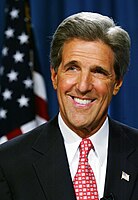U.S. presidential election, 2004
|
|
|||||||||||||||||||||||||||||
|---|---|---|---|---|---|---|---|---|---|---|---|---|---|---|---|---|---|---|---|---|---|---|---|---|---|---|---|---|---|
|
|||||||||||||||||||||||||||||
|
All 538 electoral votes of the Electoral College 270 electoral votes needed to win |
|||||||||||||||||||||||||||||
| Turnout | 56.7% |
||||||||||||||||||||||||||||
|
|||||||||||||||||||||||||||||
|
Presidential election results map. Red denotes states won by Bush/Cheney, blue denotes those won by Kerry/Edwards, light blue is the electoral vote for John Edwards (written as "John Ewards" on the elector's ballot) by a Minnesota faithless elector. Numbers indicate electoral votes allotted to the winner of each state.
|
|||||||||||||||||||||||||||||
|
|||||||||||||||||||||||||||||
The United States presidential election of 2004, the 55th quadrennial presidential election, was held on Tuesday, November 2, 2004. Republican Party candidate and incumbent President George W. Bush won re-election, defeating Democratic Party candidate John Kerry, U.S. Senator from Massachusetts and eventual United States Secretary of State.
Bush and incumbent Vice President Dick Cheney were renominated by their party with no difficulty. Howard Dean, former Governor of Vermont, was initially the frontrunner for the Democratic Party's nomination, but Kerry won nearly all of the primaries and caucuses. Kerry chose Senator John Edwards of North Carolina, who had himself sought that party's 2004 presidential nomination, to be his running mate.
Foreign policy was the dominant theme throughout the election campaign, particularly Bush's conduct of the War on Terrorism and the aftermath of the 2003 invasion of Iraq. Domestic issues were debated as well, including the economy and jobs, health care, and moral values.
...
Wikipedia




